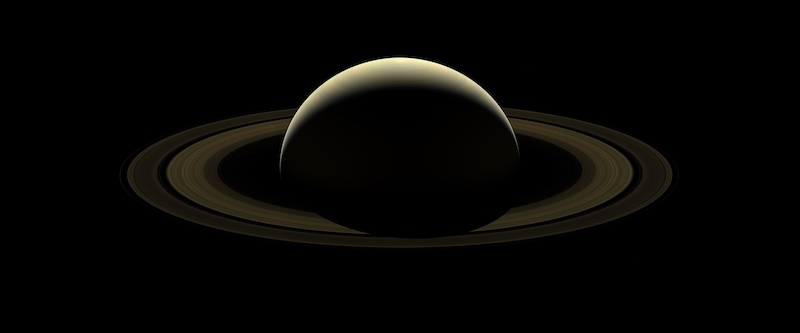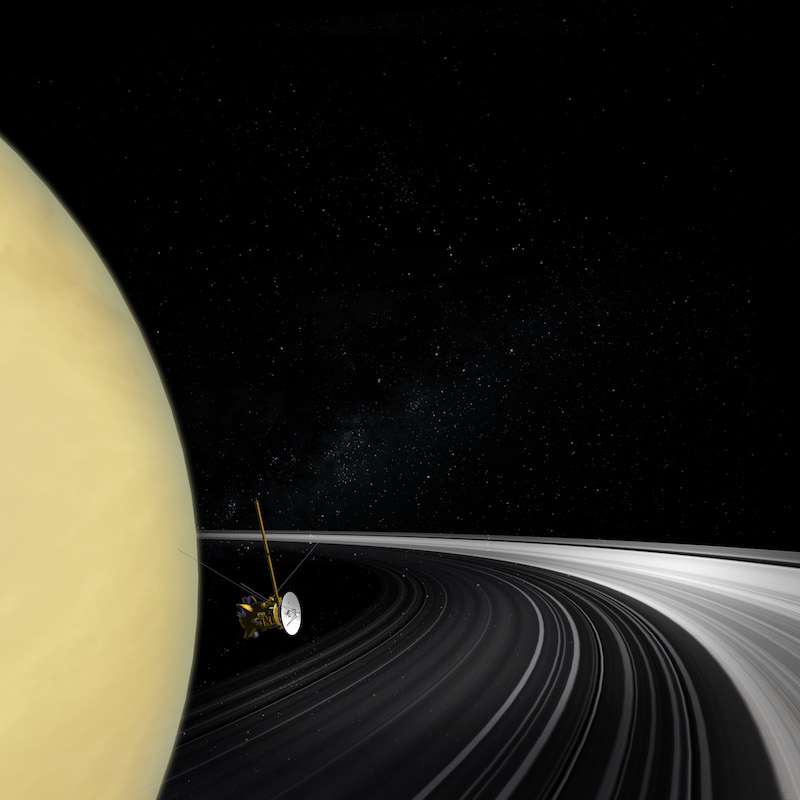
How old are Saturn’s rings? Are they as old as the planet itself or younger? Scientists have debated those questions for many decades. Now, a new study from an international group of researchers, announced on May 12, 2023, shows that the rings are young, much younger than Saturn itself. This idea fits with previous studies also suggesting a young age for the rings.
Physicist Sascha Kempf at the University of Colorado Boulder led the new study. The researchers published their new peer-reviewed findings in Science Advances on May 12, 2023.
Saturn’s rings are only 400 million years old
Saturn itself is about as old as the rest of the solar system, at 4.5 billion years. But the new results from Kempf and colleagues, show the planet’s rings as far younger, only about 400 million years at most. (The paper notes a possible range from 100 million to 400 million years). As Kempf noted:
In a way, we’ve gotten closure on a question that started with James Clerk Maxwell.
Is it an answer to the decades-old question regarding the age of the rings? Time will tell, as other scientists weigh in on the study.
Dust provides clues
How did these researchers make a determination for the age of Saturn’s rings? They looked at something that is common everywhere in the solar system: dust (referred to as micrometeoroids in the paper). Even the icy particles that make up the rings – ranging from microscopic to large boulders – have a coating of dust on them. Kempf and his team had the idea of figuring out how old Saturn’s rings are by seeing how long it takes for dust to build up on them. Kempf said:
Think about the rings like the carpet in your house. If you have a clean carpet laid out, you just have to wait. Dust will settle on your carpet. The same is true for the rings.
Cassini analyzes ring particles
It wasn’t going to be an easy task, but it was possible. NASA’s Cassini spacecraft used an instrument called the Cosmic Dust Analyzer (CDA) to study dust particles around Saturn. From 2004 to 2017, it collected 163 dust grains. That’s not a lot, but it was enough – these scientists said – to calculate how long dust has been accumulating on the rings.
The answer, it turned out, was a few hundred million years, but no more than 400 million years. That sounds like a long time, and it is. But Saturn itself is thought to be 4.5 billion years old.
If these scientists are correct, the rate of dust accumulation is slow, much less than a gram of dust added to each square foot of the rings every year. But over millions of years (as over the days or weeks in your house), the dust adds up. Other than the dust, the ring particles are almost pure water ice – 98% by volume – and “squeaky clean.” Kempf said:
It’s almost impossible to end up with something so clean.

How did Saturn’s rings form?
The results contribute to the mystery of how old Saturn’s rings are. But we still don’t know how Saturn’s rings first formed. Kempf commented:
We know approximately how old the rings are. But it doesn’t solve any of our other problems. We still don’t know how these rings formed in the first place.
In another study last year, scientists reported new evidence that Saturn’s rings formed after a former large moon, Chrysalis, broke apart after getting too close to Saturn. According to that study, a small part of the debris later became the rings. And, in that scenario, the rings formed about 160 million years ago, a number that agrees well with Kempf’s study.
The vanishing rings
What’s more, earlier research had suggested that the ring particles are very slowly falling back onto Saturn itself, as ring rain. In other words, according to the study, Saturn’s rings are gradually disappearing. They might completely vanish in another 100 million years or so. As Kempf noted:
If the rings are short-lived and dynamical, why are we seeing them now. It’s too much luck.
And indeed it might be luck for us. Consider that the oldest hominins are thought to have appeared as early as 7 million B.C.E. The earliest species of the Homo genus appeared around 2 million to 1.5 million B.C.E. If humans had evolved on Earth a billion years earlier, we might have peered through our telescopes to see a ringless Saturn. If the rings are truly much younger than Saturn, then we’re lucky to see them at all, from our human vantage point in space and time.
Bottom line: How old are Saturn’s rings? A new study suggests they’re only about 400 million years old at most, much younger than Saturn itself. Dust provided new clues.
Via University of Colorado Boulder
The post Saturn’s rings much younger than Saturn itself first appeared on EarthSky.
from EarthSky https://ift.tt/uhFBRjr

How old are Saturn’s rings? Are they as old as the planet itself or younger? Scientists have debated those questions for many decades. Now, a new study from an international group of researchers, announced on May 12, 2023, shows that the rings are young, much younger than Saturn itself. This idea fits with previous studies also suggesting a young age for the rings.
Physicist Sascha Kempf at the University of Colorado Boulder led the new study. The researchers published their new peer-reviewed findings in Science Advances on May 12, 2023.
Saturn’s rings are only 400 million years old
Saturn itself is about as old as the rest of the solar system, at 4.5 billion years. But the new results from Kempf and colleagues, show the planet’s rings as far younger, only about 400 million years at most. (The paper notes a possible range from 100 million to 400 million years). As Kempf noted:
In a way, we’ve gotten closure on a question that started with James Clerk Maxwell.
Is it an answer to the decades-old question regarding the age of the rings? Time will tell, as other scientists weigh in on the study.
Dust provides clues
How did these researchers make a determination for the age of Saturn’s rings? They looked at something that is common everywhere in the solar system: dust (referred to as micrometeoroids in the paper). Even the icy particles that make up the rings – ranging from microscopic to large boulders – have a coating of dust on them. Kempf and his team had the idea of figuring out how old Saturn’s rings are by seeing how long it takes for dust to build up on them. Kempf said:
Think about the rings like the carpet in your house. If you have a clean carpet laid out, you just have to wait. Dust will settle on your carpet. The same is true for the rings.
Cassini analyzes ring particles
It wasn’t going to be an easy task, but it was possible. NASA’s Cassini spacecraft used an instrument called the Cosmic Dust Analyzer (CDA) to study dust particles around Saturn. From 2004 to 2017, it collected 163 dust grains. That’s not a lot, but it was enough – these scientists said – to calculate how long dust has been accumulating on the rings.
The answer, it turned out, was a few hundred million years, but no more than 400 million years. That sounds like a long time, and it is. But Saturn itself is thought to be 4.5 billion years old.
If these scientists are correct, the rate of dust accumulation is slow, much less than a gram of dust added to each square foot of the rings every year. But over millions of years (as over the days or weeks in your house), the dust adds up. Other than the dust, the ring particles are almost pure water ice – 98% by volume – and “squeaky clean.” Kempf said:
It’s almost impossible to end up with something so clean.

How did Saturn’s rings form?
The results contribute to the mystery of how old Saturn’s rings are. But we still don’t know how Saturn’s rings first formed. Kempf commented:
We know approximately how old the rings are. But it doesn’t solve any of our other problems. We still don’t know how these rings formed in the first place.
In another study last year, scientists reported new evidence that Saturn’s rings formed after a former large moon, Chrysalis, broke apart after getting too close to Saturn. According to that study, a small part of the debris later became the rings. And, in that scenario, the rings formed about 160 million years ago, a number that agrees well with Kempf’s study.
The vanishing rings
What’s more, earlier research had suggested that the ring particles are very slowly falling back onto Saturn itself, as ring rain. In other words, according to the study, Saturn’s rings are gradually disappearing. They might completely vanish in another 100 million years or so. As Kempf noted:
If the rings are short-lived and dynamical, why are we seeing them now. It’s too much luck.
And indeed it might be luck for us. Consider that the oldest hominins are thought to have appeared as early as 7 million B.C.E. The earliest species of the Homo genus appeared around 2 million to 1.5 million B.C.E. If humans had evolved on Earth a billion years earlier, we might have peered through our telescopes to see a ringless Saturn. If the rings are truly much younger than Saturn, then we’re lucky to see them at all, from our human vantage point in space and time.
Bottom line: How old are Saturn’s rings? A new study suggests they’re only about 400 million years old at most, much younger than Saturn itself. Dust provided new clues.
Via University of Colorado Boulder
The post Saturn’s rings much younger than Saturn itself first appeared on EarthSky.
from EarthSky https://ift.tt/uhFBRjr

Aucun commentaire:
Enregistrer un commentaire